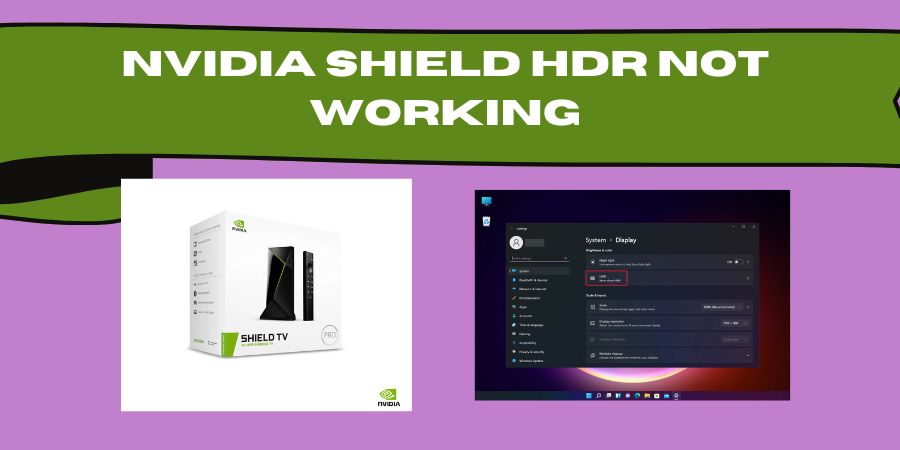Are you a proud owner of an Nvidia Shield, eagerly anticipating mind-blowing HDR visuals, only to be met with disappointment when it doesn’t work? Fret not, my friend!
In this blog post, we’ll dive into the world of Nvidia Shield HDR and uncover six handy fixes to get your HDR up and running smoothly.
So, grab your Shield and let’s embark on this quest to unleash the full potential of breathtaking visuals!
To fix Nvidia Shield HDR not working:
- Check HDMI connection.
- Update Nvidia Shield software.
- Configure display settings.
- Enable HDR on your display.
- Try different HDMI ports.
- Reset Nvidia Shield as a last resort.
Check Your HDMI Connection: The Fundamental Link
When it comes to HDR woes, a loose or faulty HDMI connection is often the culprit. Ensure that your HDMI cable is securely plugged into both your Nvidia Shield and your HDR-compatible display. Try disconnecting and reconnecting the cable to establish a stable connection. If you have another HDMI cable handy, give it a go to rule out any cable-related issues.
Update Your Nvidia Shield Software: Keep Things Fresh
Outdated software can cause compatibility issues, including problems with HDR. Make sure your Nvidia Shield is running on the latest software version.
Navigate to the settings menu, select “Device Preferences,” and check for any available system updates. Keep those updates flowing, and you’ll be one step closer to HDR paradise!
Configure Your Display Settings: Dive into the Deep End
Your display settings play a crucial role in enabling HDR. Head over to your Nvidia Shield settings and select “Display & Sound.” Within this menu, navigate to “Resolution” and ensure it’s set to the highest available resolution, which supports HDR.
Additionally, verify that the “Match Content Color Space” option is enabled for automatic HDR detection. Tweak these settings, and let the HDR magic unfold!
Enable HDR on Your Display: Unleash the Beast
Sometimes, HDR needs to be enabled on your display as well. Check your TV or monitor settings for an HDR option, and make sure it’s turned on.
Each manufacturer has its own unique way of accessing these settings, so consult your display’s manual or do a quick online search for specific instructions.
Once HDR is enabled on both ends, you’ll be blown away by the vibrant colors and stunning contrast!
Test Different HDMI Ports: The Quest for Compatibility
Believe it or not, some HDMI ports on your TV or monitor may not support HDR. If you’re facing issues, try connecting your Nvidia Shield to a different HDMI port and see if it makes a difference.
Look for HDMI ports labeled with terms like “ARC,” “HDCP 2.2,” or “HDMI 2.0” to ensure HDR compatibility.
Don’t be discouraged if the first port doesn’t work; it’s all about finding the right match!
Reset Your Nvidia Shield:
If all else fails, it’s time to bring out the big guns – a complete reset of your Nvidia Shield. While this step should be your last resort, it can often resolve stubborn HDR issues. Head to the settings menu, select “Device Preferences,” then “Reset.”
Choose the option to reset your Shield to factory settings, and let it work its magic. Just remember to back up any important data beforehand!
Verify HDR Compatibility: The Compatibility Spell
Before delving into complex fixes, let’s ensure that your display is HDR-compatible.
Check the specifications of your TV or monitor to confirm its compatibility with HDR formats such as HDR10 or Dolby Vision.
If your display lacks HDR support, unfortunately, HDR functionality won’t be available. Consider upgrading to a compatible display to unlock the full potential of HDR.
Adjust HDR Settings in Apps: Mastering the In-App Realm
Sometimes, HDR may not activate within specific apps or games, even if it works elsewhere.
Navigate to the settings menu within the problematic app or game and look for HDR-related options.
Ensure that HDR is enabled within the app settings. Additionally, check for any advanced options related to HDR calibration or color space.
Making adjustments within the app itself can often resolve HDR inconsistencies.
Disable Power Saving Features: Banishing the Energy-Saving
Demons Power-saving features on your Nvidia Shield or display can interfere with HDR functionality.
Navigate to your Nvidia Shield settings and disable any power-saving or energy-efficient settings.
Similarly, access your display settings and ensure that power-saving features like “Eco mode” or “Energy Saver” are turned off.
By giving HDR the full power it needs, you’ll witness visuals that will leave you in awe!
Update Your Display Firmware: Breathing New Life
Just as software updates for your Nvidia Shield are crucial, firmware updates for your display can also improve HDR performance. Visit the manufacturer’s website for your TV or monitor and search for any available firmware updates.
Follow the instructions provided to install the latest firmware version, as it may contain bug fixes and improvements specifically related to HDR.
Check HDMI CEC Settings: Communication is Key
HDMI-CEC (Consumer Electronics Control) allows devices connected via HDMI to communicate with each other.
However, conflicting CEC settings can sometimes disrupt HDR functionality.
Navigate to your Nvidia Shield settings, select “Device Preferences,” and then “HDMI CEC.” Disable or toggle off any HDMI CEC-related options.
Contact Nvidia Support: Seek Assistance from the Experts
If you’ve exhausted all the fixes mentioned above and are still grappling with HDR issues, it’s time to reach out to Nvidia support. Visit the official Nvidia website and locate the support section.
Contact their customer support via email, live chat, or phone and explain your HDR problems in detail.
The knowledgeable support team can guide you further, provide specific troubleshooting steps, or offer hardware replacement if necessary.

